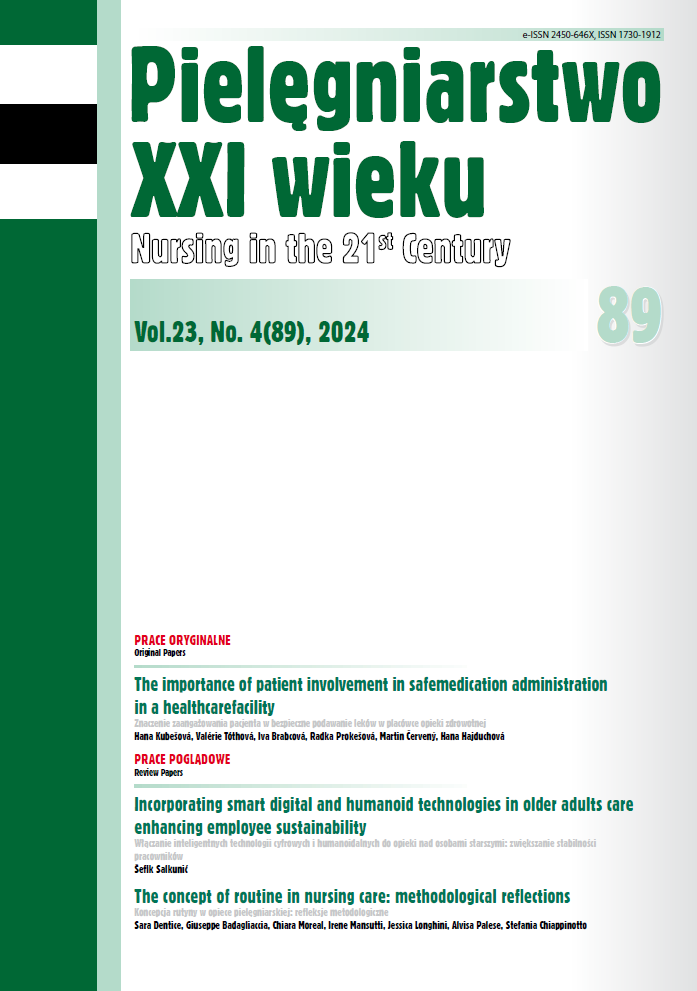Włączanie inteligentnych technologii cyfrowych i humanoidalnych do opieki nad osobami starszymi: zwiększanie zrównoważonego rozwoju pracowników
DOI:
https://doi.org/10.2478/pielxxiw-2024-0042Słowa kluczowe:
zdolność do pracy, technologie cyfrowe, roboty, opieka instytucjonalna nad starszymi dorosłymiAbstrakt
WŁĄCZANIE INTELIGENTNYCH TECHNOLOGII CYFROWYCH I HUMANOIDALNYCH DO OPIEKI NAD OSOBAMI STARSZYMI: ZWIĘKSZANIE ZRÓWNOWAŻONEGO ROZWOJU PRACOWNIKÓW
Cel pracy. Niniejszy artykuł bada potencjalny wpływ integracji DT i robotów w ICE na zdolność do pracy pracowników opieki, koncentrując się na redukcji absencji, wspieraniu nowych pracowników oraz poprawie satysfakcji z pracy wśród opiekunów.
Materiał i metody. Przeprowadzono integracyjny przegląd literatury zgodnie z wytycznymi PRISMA, przeszukując bazy danych, takie jak Web of Science, PubMed i COBISS, używając określonych słów kluczowych związanych z DT i robotami w ICE. Wybrano odpowiednie artykuły na podstawie kryteriów włączenia i wyłączenia.
Wyniki. Przegląd zidentyfikował 48 odpowiednich artykułów, z których 7 spełniało kryteria włączenia. Wyniki sugerują, że integracja DT i robotów w ICE może poprawić satysfakcję z pracy, wspierać naukę i rozwój umiejętności oraz zwiększać wsparcie organizacyjne dla opiekunów.
Wnioski. Badania pokazują, że technologie cyfrowe i roboty mają znaczący wpływ na zdolność do pracy, jednak są niewystarczająco zbadane. Ich integracja może zmniejszyć absencję i zwiększyć zadowolenie z pracy, ale stawia wyzwania takie jak uzasadnienie inwestycji i obawy personelu. Zrozumienie ich wpływu na zdrowie pracowników jest kluczowe. Potrzebne są dalsze badania nad dynamiką zespołów wielokulturowych i trwałością systemów opieki zdrowotnej. Wdrażanie tych technologii napotyka trudności, zwłaszcza w krajach rozwijających się.
Bibliografia
1. Eurostat. Long-term care beds in nursing and residential care facilities. 2020.
2. Spasova S, Baeten R, Vanhercke B. Challenges in Long-term Care in Europe. Eurohealth. 2018; 24: 7-12.
3. Utharman TC. Older nurses: A literature review on challenges, factors in early retirement and workforce retention. Proc. Singapore Healthc. 2016; 25(1): 50-55.
4. Köllner W. Psychisch krank in der Pflege - Psychische Belastungen durch dem Beruf, Möglichkeiten zu Prävention und Rehabilitation. Bonn: Friedrich - Ebner - Stifftung. Abteilung Wirtschafts - und Sozialpolitik; 2015.
5. Gröning W, Kromar K, Konrad N. Älter werden im Pflegeberuf. [cited February 2018]. Available from: https://www.bgw-online.de/SharedDocs/Downloads/DE/Medientypen/BGW%20Broschueren/BGW04-09-012_Aelter-werden-im-Pflegeberuf_Download.pdf?__blob=publicationFile.
6. Prakash KC, et al. Intention to retire in Employees over 50 years. What is the Role of Work ability and Work Life Satisfaction. Int. J. Environ. Res. Public Health. 2019; 16(14): 2500.
7. Ilmarinen J. New dimensions of workability. Scand. J. Work Environ. Health. 2005; 1280: 3-7.
8. Ilmarinen J. From work Ability Research to Implementation. Int. J. Environ. Res. Public Health. 2019; 16(16): 2882.
9. Standeker N. Factors Affecting Work Ability Among Employees in Institutional Care of the Elderly across Austria Croatia and Slovenia. Good Quality of Old Age: Journal for Gerontology and Intergenerational Relations. 2021; 24(1): 31-41.
10. Page J, McKenzie J, Bossuyt P. The PRISMA 2020 statement: an update guideline for reporting systematic reviews. Syst. Rev. 2021; 10:89. Available from: https://doi.org/10.1186/s13643-021-01626-4.
11. Huisman C, Kort H. Two-Year Use of Care Robot Zora in Dutch Nursing Homes: An Evaluation Study. Healthcare. 2019; 7(1): 31.
12. Zhao Y, Rakhani ZF, Schariff-Gazali S, et al. Defining the concepts of a smart nursing home and its potential technology utilities that integrate medical services and are acceptable to stakeholders: a scoping review. BMC Geriatr. 2022; 22(1): 787.
13. Zamiri M, Sarraipa J, Luis-Ferreira F, et al. Review of technology-supported multimodal solutions for people with dementia. Sensors (Basel). 2021; 14: 4806.
14. Jadan L, Gill TK, Taylor A, et al. Identifying opportunities, and motivation to enhance capabilities, influencing the development of a personalized digital health hub model of care for hip fractures: mixed methods exploratory study. J. Med. Internet. Res. 2021; 23(10): e26886. vAvailable from: https://www.ncbi.nlm.nih.gov/pmc/articles/PMC8587193/.
15. Alexander GL, Georgiou A, Doughtry K, et al. Advancing health information technology roadmaps in long term care. Int. J. Med. Inform. 2020; 136:104088. Available from: https://doi.org/10.1016/j.ijmedinf.2020.104088.
16. Casey D, Barett G, Kovacic T, et al. The perceptions of people with dementia and key. Int. J. Environ. Res. Public Health. 2020; 17(22):8621. Available from: https://doi.org/10.3390/ijerph17228621.
17. Krick T, Huter K, Domhoff D, et al. Digital technology and nursing care: a scoping review on acceptance, effectiveness and efficiency studies of informal and formal care technologies. BMC Health Serv. Res. 2019. Available from: https://bmchealthservres.biomedcentral.com/articles/10.1186/s12913-019-4238-3.
18. Melkas H, Henalla L, Pekkarinen S, et al. Impacts of robot implementation on care personnel and clients in elderly-care institutions. Int. J. Med. Inform. 2020; 134: 104041.
19. Coco K, Kangasnieni M, Rantanen T. Care personnel’s attitudes and fears toward care robots in elderly care: a comparison of data from the care personnel in Finland and Japan. J. Nurs. Sch. 2018; 50(6): 634-644.
20. Papadopoulos I, Kouliuglioti C, Ali S. Views of nurses and other health and social care workers on the use of assistive humanoid and animal-like robots in health and social care: a scoping review. Contemp. Nurse. 2018; 54(4-5): 425-442.
21. Fosen F, Sorgner A. Mapping the future of occupations: transformative and destructive effects of new digital technologies on jobs. Foresight. 2019; 13(2): 10-18.
22. Nübler I. New technologies: a jobless future or golden age of job creation? Int. Labour Office Res. Dept. Working Paper. 2016; 13(22-23).
23. Yadav SR. Robotics in Nursing. [cited November 2022]. Available from: https://www.linkedin.com/pulse/robotics-nursing-dr-shruti-yadav.
24. Bryndal A, Glowinski S, Grochulska A. Influence of Occupation on the Prevalence of Spinal Pain among Physiotherapists and Nurses. J. Clin. Med. 2022; 11(19):5600.
25. National Academies of Sciences, Engineering, and Medicine. The future of nursing 2020–2030: Charting a path to achieve health equity. Washington, DC: The National Academies Press; 2021. Available from: https://doi.org/10.17226/25982.
Pobrania
Opublikowane
Numer
Dział
Licencja
Prawa autorskie (c) 2024 Autorzy

Utwór dostępny jest na licencji Creative Commons Uznanie autorstwa 4.0 Międzynarodowe.




